Macroeconomics Assignment: Automation, Globalization and Growth
VerifiedAdded on 2019/11/19
|6
|1358
|242
Homework Assignment
AI Summary
This document presents a comprehensive solution to a macroeconomics assignment. The first section analyzes a closed economy, calculating private and public savings, national savings, and investment. The second part discusses labor productivity, its determinants, and how to measure economic growth. The third section addresses Hans Rosling's views on China's economic growth, benefits of free trade, and the importance of adjusting income per person for inflation. Finally, the assignment explores the impact of automation and globalization on unemployment, providing examples and discussing policy recommendations. The document also includes references to relevant economic literature.
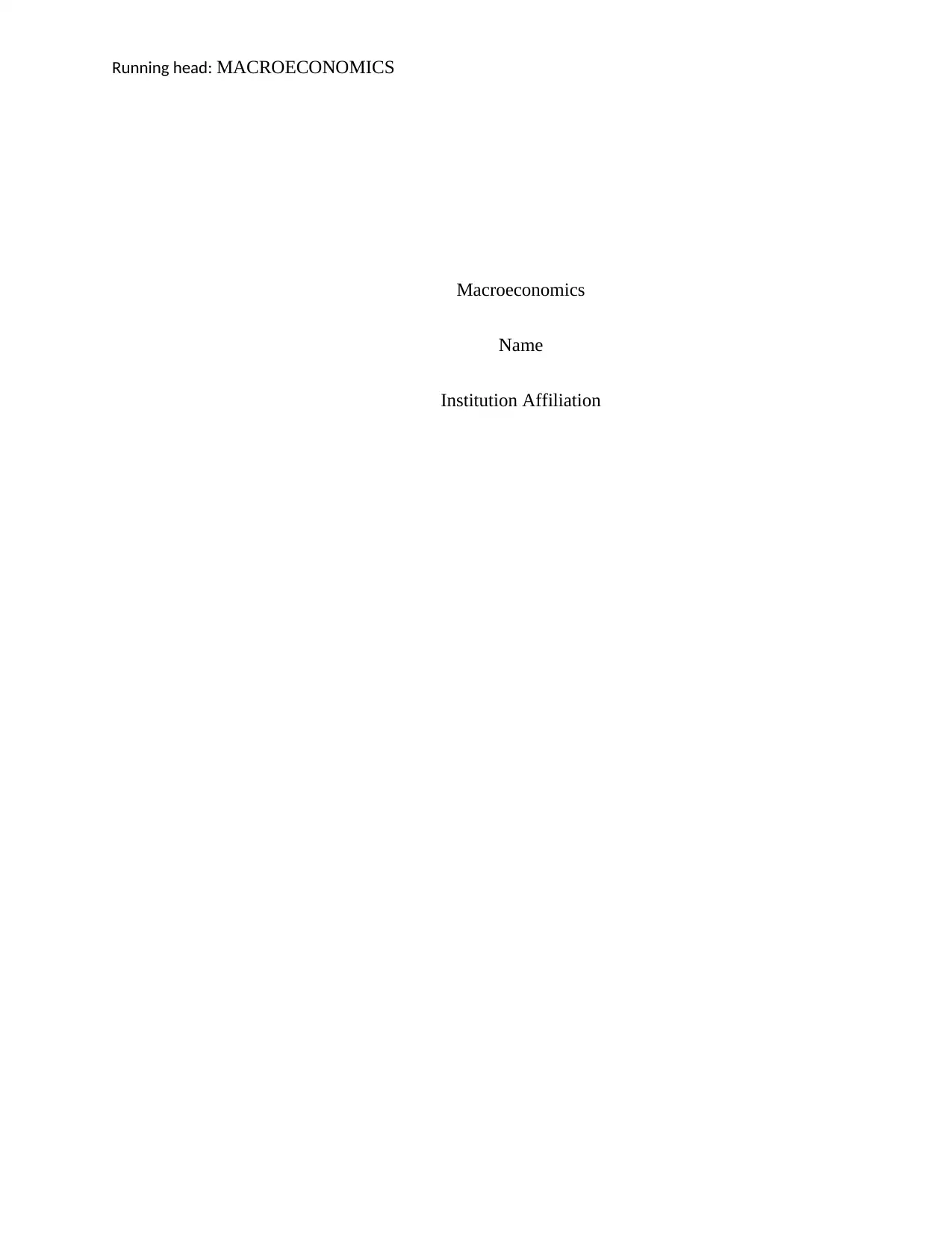
Running head: MACROECONOMICS
Macroeconomics
Name
Institution Affiliation
Macroeconomics
Name
Institution Affiliation
Paraphrase This Document
Need a fresh take? Get an instant paraphrase of this document with our AI Paraphraser
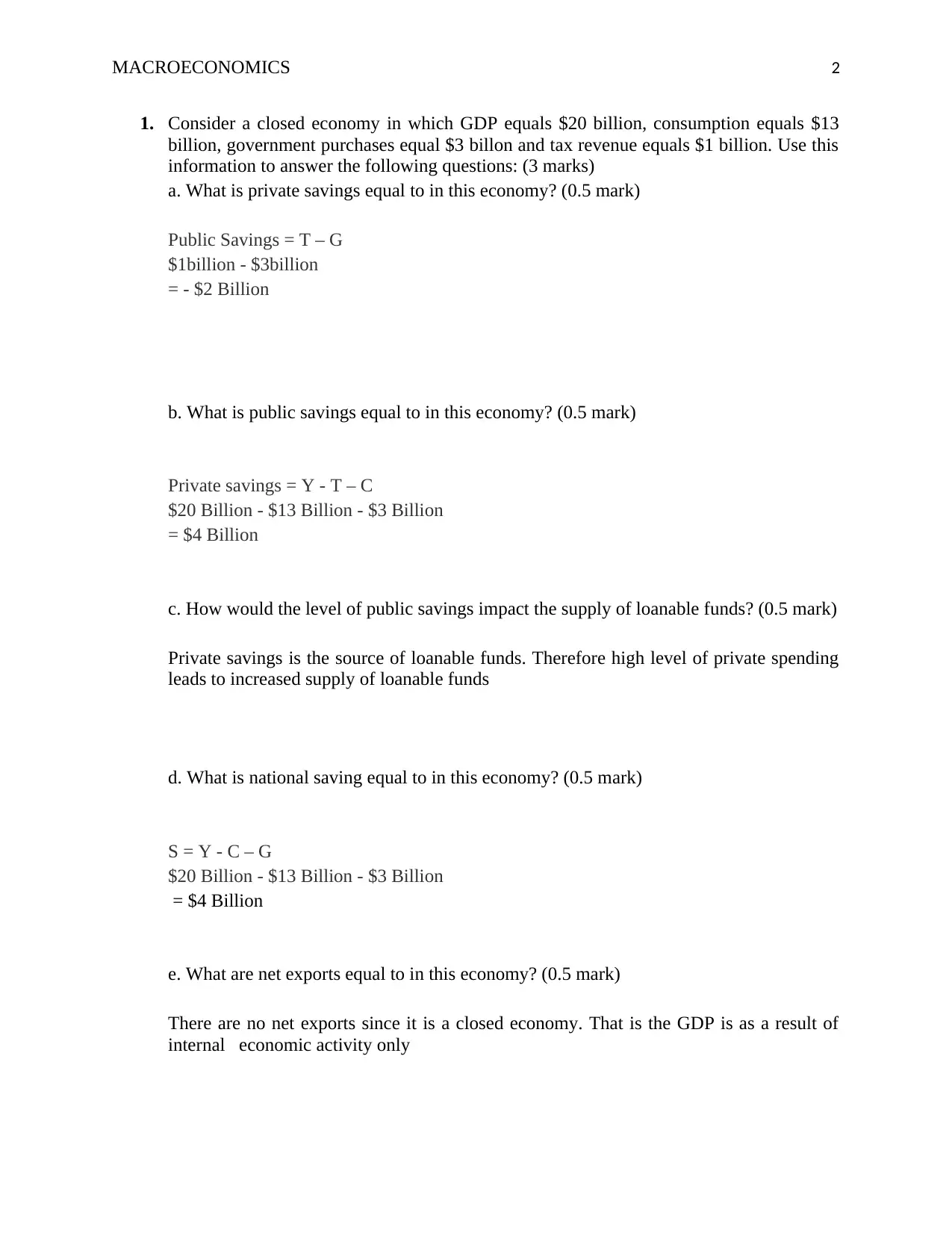
MACROECONOMICS 2
1. Consider a closed economy in which GDP equals $20 billion, consumption equals $13
billion, government purchases equal $3 billon and tax revenue equals $1 billion. Use this
information to answer the following questions: (3 marks)
a. What is private savings equal to in this economy? (0.5 mark)
Public Savings = T – G
$1billion - $3billion
= - $2 Billion
b. What is public savings equal to in this economy? (0.5 mark)
Private savings = Y - T – C
$20 Billion - $13 Billion - $3 Billion
= $4 Billion
c. How would the level of public savings impact the supply of loanable funds? (0.5 mark)
Private savings is the source of loanable funds. Therefore high level of private spending
leads to increased supply of loanable funds
d. What is national saving equal to in this economy? (0.5 mark)
S = Y - C – G
$20 Billion - $13 Billion - $3 Billion
= $4 Billion
e. What are net exports equal to in this economy? (0.5 mark)
There are no net exports since it is a closed economy. That is the GDP is as a result of
internal economic activity only
1. Consider a closed economy in which GDP equals $20 billion, consumption equals $13
billion, government purchases equal $3 billon and tax revenue equals $1 billion. Use this
information to answer the following questions: (3 marks)
a. What is private savings equal to in this economy? (0.5 mark)
Public Savings = T – G
$1billion - $3billion
= - $2 Billion
b. What is public savings equal to in this economy? (0.5 mark)
Private savings = Y - T – C
$20 Billion - $13 Billion - $3 Billion
= $4 Billion
c. How would the level of public savings impact the supply of loanable funds? (0.5 mark)
Private savings is the source of loanable funds. Therefore high level of private spending
leads to increased supply of loanable funds
d. What is national saving equal to in this economy? (0.5 mark)
S = Y - C – G
$20 Billion - $13 Billion - $3 Billion
= $4 Billion
e. What are net exports equal to in this economy? (0.5 mark)
There are no net exports since it is a closed economy. That is the GDP is as a result of
internal economic activity only
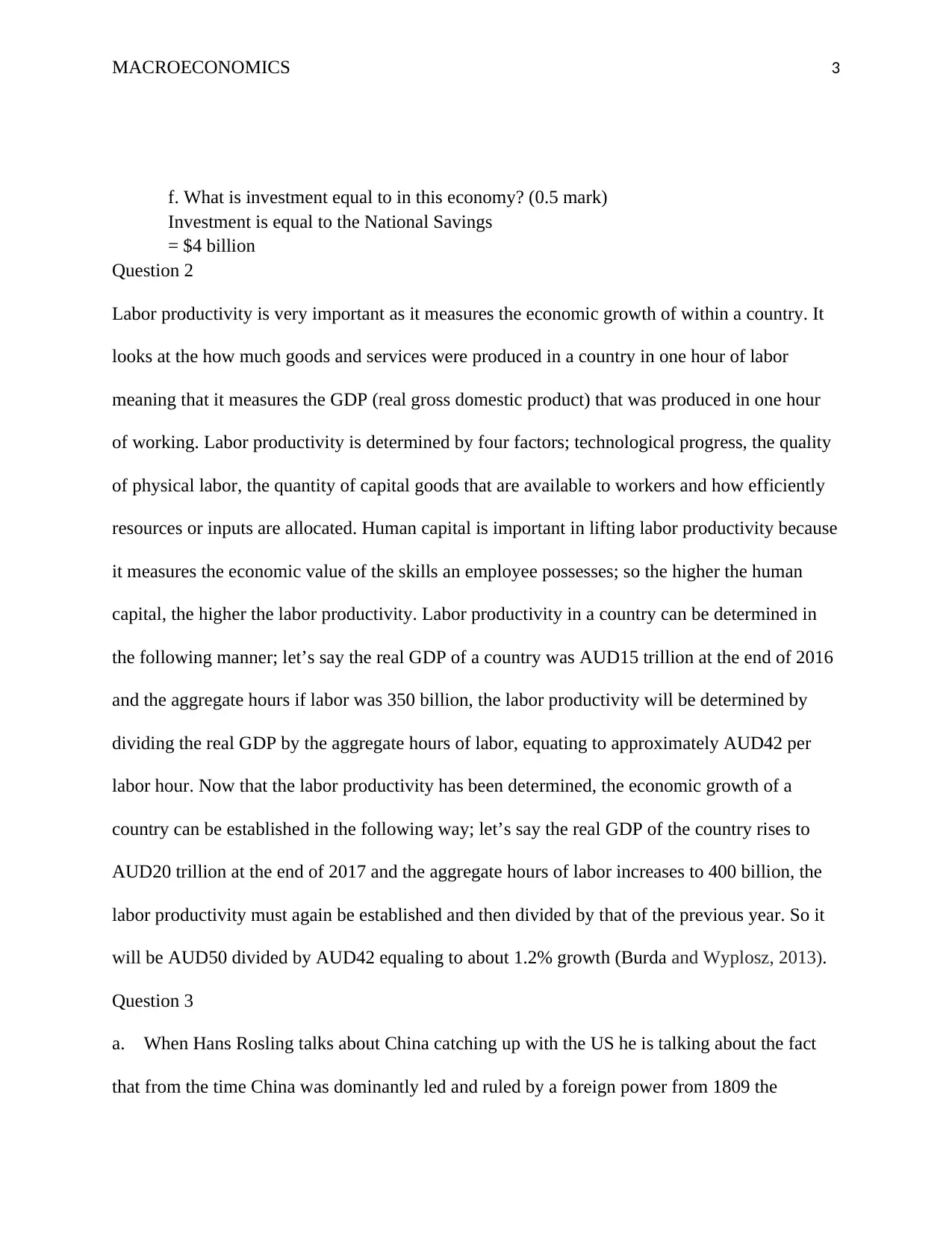
MACROECONOMICS 3
f. What is investment equal to in this economy? (0.5 mark)
Investment is equal to the National Savings
= $4 billion
Question 2
Labor productivity is very important as it measures the economic growth of within a country. It
looks at the how much goods and services were produced in a country in one hour of labor
meaning that it measures the GDP (real gross domestic product) that was produced in one hour
of working. Labor productivity is determined by four factors; technological progress, the quality
of physical labor, the quantity of capital goods that are available to workers and how efficiently
resources or inputs are allocated. Human capital is important in lifting labor productivity because
it measures the economic value of the skills an employee possesses; so the higher the human
capital, the higher the labor productivity. Labor productivity in a country can be determined in
the following manner; let’s say the real GDP of a country was AUD15 trillion at the end of 2016
and the aggregate hours if labor was 350 billion, the labor productivity will be determined by
dividing the real GDP by the aggregate hours of labor, equating to approximately AUD42 per
labor hour. Now that the labor productivity has been determined, the economic growth of a
country can be established in the following way; let’s say the real GDP of the country rises to
AUD20 trillion at the end of 2017 and the aggregate hours of labor increases to 400 billion, the
labor productivity must again be established and then divided by that of the previous year. So it
will be AUD50 divided by AUD42 equaling to about 1.2% growth (Burda and Wyplosz, 2013).
Question 3
a. When Hans Rosling talks about China catching up with the US he is talking about the fact
that from the time China was dominantly led and ruled by a foreign power from 1809 the
f. What is investment equal to in this economy? (0.5 mark)
Investment is equal to the National Savings
= $4 billion
Question 2
Labor productivity is very important as it measures the economic growth of within a country. It
looks at the how much goods and services were produced in a country in one hour of labor
meaning that it measures the GDP (real gross domestic product) that was produced in one hour
of working. Labor productivity is determined by four factors; technological progress, the quality
of physical labor, the quantity of capital goods that are available to workers and how efficiently
resources or inputs are allocated. Human capital is important in lifting labor productivity because
it measures the economic value of the skills an employee possesses; so the higher the human
capital, the higher the labor productivity. Labor productivity in a country can be determined in
the following manner; let’s say the real GDP of a country was AUD15 trillion at the end of 2016
and the aggregate hours if labor was 350 billion, the labor productivity will be determined by
dividing the real GDP by the aggregate hours of labor, equating to approximately AUD42 per
labor hour. Now that the labor productivity has been determined, the economic growth of a
country can be established in the following way; let’s say the real GDP of the country rises to
AUD20 trillion at the end of 2017 and the aggregate hours of labor increases to 400 billion, the
labor productivity must again be established and then divided by that of the previous year. So it
will be AUD50 divided by AUD42 equaling to about 1.2% growth (Burda and Wyplosz, 2013).
Question 3
a. When Hans Rosling talks about China catching up with the US he is talking about the fact
that from the time China was dominantly led and ruled by a foreign power from 1809 the
⊘ This is a preview!⊘
Do you want full access?
Subscribe today to unlock all pages.

Trusted by 1+ million students worldwide
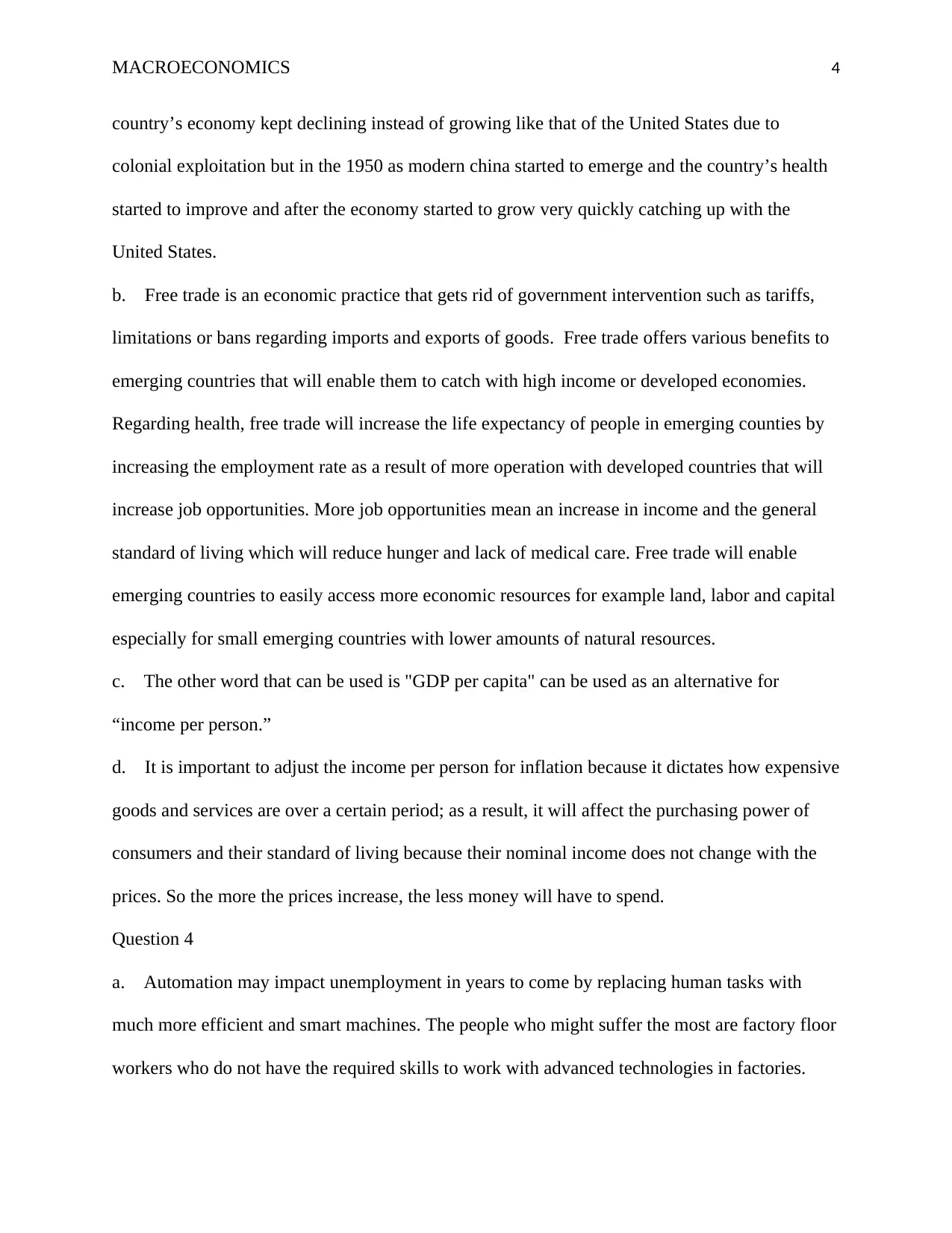
MACROECONOMICS 4
country’s economy kept declining instead of growing like that of the United States due to
colonial exploitation but in the 1950 as modern china started to emerge and the country’s health
started to improve and after the economy started to grow very quickly catching up with the
United States.
b. Free trade is an economic practice that gets rid of government intervention such as tariffs,
limitations or bans regarding imports and exports of goods. Free trade offers various benefits to
emerging countries that will enable them to catch with high income or developed economies.
Regarding health, free trade will increase the life expectancy of people in emerging counties by
increasing the employment rate as a result of more operation with developed countries that will
increase job opportunities. More job opportunities mean an increase in income and the general
standard of living which will reduce hunger and lack of medical care. Free trade will enable
emerging countries to easily access more economic resources for example land, labor and capital
especially for small emerging countries with lower amounts of natural resources.
c. The other word that can be used is "GDP per capita" can be used as an alternative for
“income per person.”
d. It is important to adjust the income per person for inflation because it dictates how expensive
goods and services are over a certain period; as a result, it will affect the purchasing power of
consumers and their standard of living because their nominal income does not change with the
prices. So the more the prices increase, the less money will have to spend.
Question 4
a. Automation may impact unemployment in years to come by replacing human tasks with
much more efficient and smart machines. The people who might suffer the most are factory floor
workers who do not have the required skills to work with advanced technologies in factories.
country’s economy kept declining instead of growing like that of the United States due to
colonial exploitation but in the 1950 as modern china started to emerge and the country’s health
started to improve and after the economy started to grow very quickly catching up with the
United States.
b. Free trade is an economic practice that gets rid of government intervention such as tariffs,
limitations or bans regarding imports and exports of goods. Free trade offers various benefits to
emerging countries that will enable them to catch with high income or developed economies.
Regarding health, free trade will increase the life expectancy of people in emerging counties by
increasing the employment rate as a result of more operation with developed countries that will
increase job opportunities. More job opportunities mean an increase in income and the general
standard of living which will reduce hunger and lack of medical care. Free trade will enable
emerging countries to easily access more economic resources for example land, labor and capital
especially for small emerging countries with lower amounts of natural resources.
c. The other word that can be used is "GDP per capita" can be used as an alternative for
“income per person.”
d. It is important to adjust the income per person for inflation because it dictates how expensive
goods and services are over a certain period; as a result, it will affect the purchasing power of
consumers and their standard of living because their nominal income does not change with the
prices. So the more the prices increase, the less money will have to spend.
Question 4
a. Automation may impact unemployment in years to come by replacing human tasks with
much more efficient and smart machines. The people who might suffer the most are factory floor
workers who do not have the required skills to work with advanced technologies in factories.
Paraphrase This Document
Need a fresh take? Get an instant paraphrase of this document with our AI Paraphraser

MACROECONOMICS 5
Further, these people’s chances of finding a profitable employment will be lower because as time
passes the occupation that used to help them get back on their feet are disappearing. This will
create inequality in the job market as demand for skilled workers will increase while that of
unskilled workers will decrease; the same will happen to the income. There are various things
policy makers can do to address this situation including boosting digital literacy and
infrastructure in schools as well as retraining in companies and ensuring that ever type of worker,
skilled or unskilled is equally protected in the enterprise.
b. One industry that has suffered job losses as a result of globalization is the car manufacturing
industry in Australia; many companies such as Toyota want to leave the Australian market
because of the high production costs when compared to places like China or the United States
causing jobs to move overseas. Globalization creates unemployment in an industry because it
moves job patterns, ways and wages causing instabilities in the employment market because
developing countries the same capabilities to produce high-value-added components as
developed countries. Job patterns, ways and wages and other aspects such as the price of goods
have suffered irreversible changes because certain parts of international supply chains have been
relocated such as what is happening with companies like Toyota who are relocating factories to
parts of the world where the cost of production is cheaper (Mankiw, 2014).
c. One thing that I found interesting from reading the Report was the number of opportunities
that automation creates. I found this interesting because I always looked at automation is a
negative manner, focusing on the way it dehumanizes a lot of processes in an industry but this
article opened my eyes to how beneficial it could be if used correctly.
Further, these people’s chances of finding a profitable employment will be lower because as time
passes the occupation that used to help them get back on their feet are disappearing. This will
create inequality in the job market as demand for skilled workers will increase while that of
unskilled workers will decrease; the same will happen to the income. There are various things
policy makers can do to address this situation including boosting digital literacy and
infrastructure in schools as well as retraining in companies and ensuring that ever type of worker,
skilled or unskilled is equally protected in the enterprise.
b. One industry that has suffered job losses as a result of globalization is the car manufacturing
industry in Australia; many companies such as Toyota want to leave the Australian market
because of the high production costs when compared to places like China or the United States
causing jobs to move overseas. Globalization creates unemployment in an industry because it
moves job patterns, ways and wages causing instabilities in the employment market because
developing countries the same capabilities to produce high-value-added components as
developed countries. Job patterns, ways and wages and other aspects such as the price of goods
have suffered irreversible changes because certain parts of international supply chains have been
relocated such as what is happening with companies like Toyota who are relocating factories to
parts of the world where the cost of production is cheaper (Mankiw, 2014).
c. One thing that I found interesting from reading the Report was the number of opportunities
that automation creates. I found this interesting because I always looked at automation is a
negative manner, focusing on the way it dehumanizes a lot of processes in an industry but this
article opened my eyes to how beneficial it could be if used correctly.
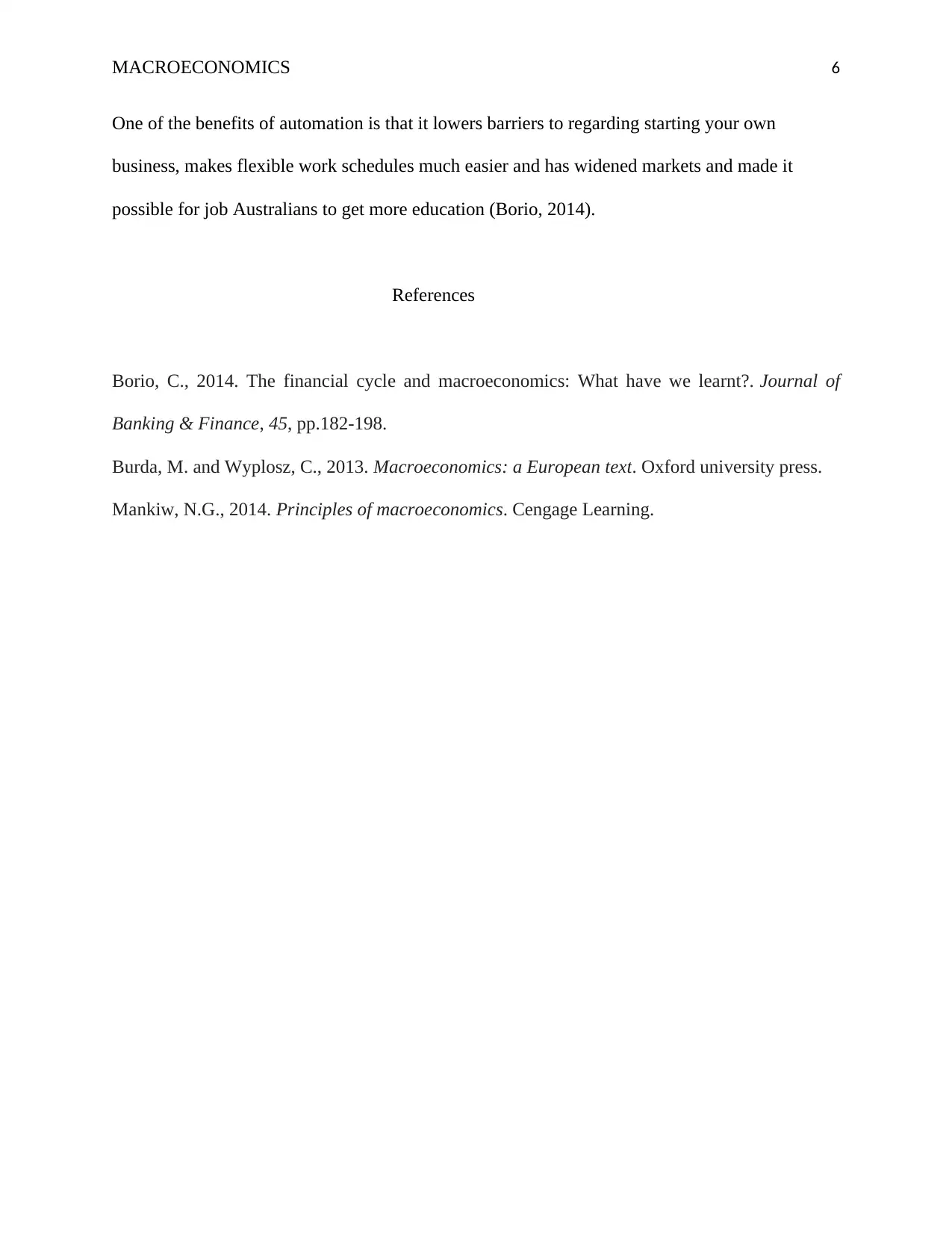
MACROECONOMICS 6
One of the benefits of automation is that it lowers barriers to regarding starting your own
business, makes flexible work schedules much easier and has widened markets and made it
possible for job Australians to get more education (Borio, 2014).
References
Borio, C., 2014. The financial cycle and macroeconomics: What have we learnt?. Journal of
Banking & Finance, 45, pp.182-198.
Burda, M. and Wyplosz, C., 2013. Macroeconomics: a European text. Oxford university press.
Mankiw, N.G., 2014. Principles of macroeconomics. Cengage Learning.
One of the benefits of automation is that it lowers barriers to regarding starting your own
business, makes flexible work schedules much easier and has widened markets and made it
possible for job Australians to get more education (Borio, 2014).
References
Borio, C., 2014. The financial cycle and macroeconomics: What have we learnt?. Journal of
Banking & Finance, 45, pp.182-198.
Burda, M. and Wyplosz, C., 2013. Macroeconomics: a European text. Oxford university press.
Mankiw, N.G., 2014. Principles of macroeconomics. Cengage Learning.
⊘ This is a preview!⊘
Do you want full access?
Subscribe today to unlock all pages.

Trusted by 1+ million students worldwide
1 out of 6
Related Documents
Your All-in-One AI-Powered Toolkit for Academic Success.
+13062052269
info@desklib.com
Available 24*7 on WhatsApp / Email
![[object Object]](/_next/static/media/star-bottom.7253800d.svg)
Unlock your academic potential
Copyright © 2020–2025 A2Z Services. All Rights Reserved. Developed and managed by ZUCOL.





